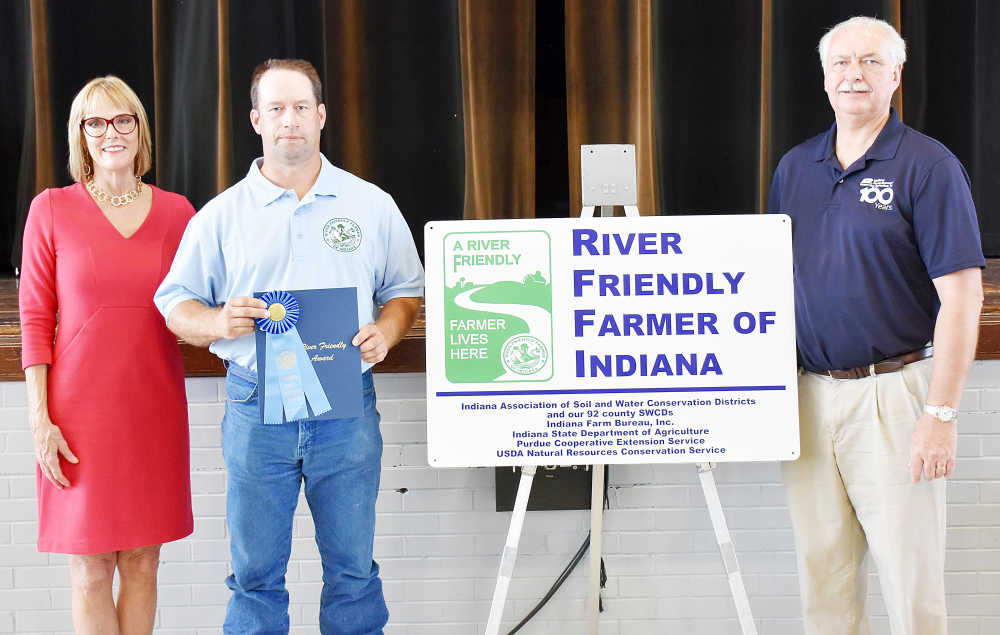Adam Dobson named River Friendly Farmer

What makes a farm or a farmer river friendly?
It can be a lot of factors. But as Putnam County’s Adam Dobson reflects on the River Friendly Farmer award he was presented in 2019, one important factor is keep the soil — and all its inputs — right where it is.
“Through no-till and cover crops, you’re trying to keep all your inputs on the land. Over time, you’re hoping to use a lot less inputs,” Dobson said. “The USDA’s general premise is to ever increase yield and production, but lower inputs, whether it by fuels, pesticides, herbicides, whatever.”
For his efforts in keeping the soil and its inputs out of local creeks and rivers, Dobson will be honored at the upcoming Putnam County Soil and Water Conservation District annual meeting and dinner, set for Thursday, Jan. 23 at the Putnam County Fairgrounds Community Building.
Also honored at the meeting will be Conservationist of the Year Jim Woody and Woodland Owner of the Year Owner of the Year Tom Webb.
For their stories and more information about the Putnam County SWCD, check out the special B section in today’s paper.
Dobson Farms raises beef cattle and produces rotational row cropping of corn, soybeans, wheat and oats.
Dobson believes such diversity also contributes to his river friendly status.
“One of the things that I’m different form my peers or counterparts is, I still raise a lot of wheat,” Dobson said. “That’s not something you see a lot of around here. Most of my neighbors raise corn or soybeans, but if they do, it’s on a small scale.”
As such, the land utilized for wheat is pretty much constantly in production, harvesting the wheat in early July then planting soybeans thereafter.
It also helps his bottom line, as 300 or so of his acres are actually getting 600 acres of yield each year.
Dobson uses a three-crop rotation on the row crop acreage utilizing cover crops, buffer strips, waterways, and terraces. Crops are planted in a no-till system with variable rate fertilizer application.
The farm has experienced more consistent yields and better drainage by practicing no-till. With the planting of cover crops and the use of buffer strips and waterways, Dobson has experienced less erosion and soil loss during the large rain events the past few years.
The farm also includes timbered acreage, which Dobson logs himself.
By utilizing modern technology with a do-it-yourself ethic of previous generations, Dobson is a rarity in agriculture these days — a first-generation farmer. Though only a generation removed from the farm, he grew up the child of two school teachers.
“I was told, ‘There’s no way you can farm,’” Dobson recalls, adding that was told, “It’s way too capital intensive. You have to have 10,000 acres to survive.”
In 20 years of farming, he’s managed to make a go of it on a lot less.
While the support of a separate income and benefits from his wife has made a difference, so has utilizing programs from the SWCD, NRCS and other agencies housed at the USDA building at 1007 Mill Pond Lane, Greencastle.
“It’s hard to say plant 10 percent of your field in native grass and wildflowers,” Dobson said. “Well, I’m not making money, so how am I supposed to do that?”
The answer, he said, are the cost share programs offered by the agencies.
“They have a lot of somewhat small scale cost share programs at that office,” Dobson said. “There are things to help a farmer who doesn’t make a lot of money raising corn and soybeans. Over the two decades I’ve been farming, I’ve used a lot of those programs.”
He also knows that having the proper equipment to do much of this work himself is helpful.
“If we need a waterway, we need a terrace, we need a strip, we can just go ahead and do that,” Dobson said.
Dobson also doesn’t try to take too much credit for the successes, noting that there are after all fewer farmers than there used to be.
“It’s not that I’m a super standout,” he said. “I try to do all that stuff. I’m not perfect.”
He is also a past board member of Farm Bureau, a member of Ducks Unlimited and a member of Gobin United Methodist Church.
Even as he sees a plenty of problems in the industry as a whole, Dobson also believes there are a lot of things farmers should be proud of and should be communicating to the public.
“I do know as a whole, we’re doing a better job of farming — economically, environmentally, in terms of health,” Dobson said. “The food supply, the food availability and the food diversity is better than it was.”
